Physical Address
304 North Cardinal St.
Dorchester Center, MA 02124
Frozen section performance in the transplant setting is dominated by evaluation of donor organs to assess suitability for transplantation. Knowledge regarding certain clinical aspects of the donor is valuable, and this will be addressed first. We will then focus on frozen section work flow and analysis in relation to kidney and liver transplantation. Discussion emphasizes these organs because their assessment comprises the overwhelming majority of transplant-related requests. Brief mention will also be made of biopsy of nontransplant organs from the donor and some aspects of frozen section consultation in the posttransplant setting.
The continuing shortage of donor organs for lifesaving transplants has led to the utilization of organs from donors with underlying conditions or circumstances that require stringent perioperative evaluation. In this circumstance the pathologist serves as a gatekeeper to ensure that usable organs are not discarded and defective organs are not inappropriately transplanted into desperately ill patients. While frozen section is not infallible, it is a powerful tool that can contribute to these goals. Table 19-1 roughly parallels the work flow of the pathologist in these situations and will serve as an outline for discussion.
|
Donor organ frozen section is most commonly requested when the organ is recovered from an extended criteria donor. In the United States, Organ Procurement and Transportation Network (OPTN) policy (3.5.1) defines extended criteria donors in the context of kidney donation as:
Any donor 60 years of age or older
Any donor 50 to 59 years of age with cerebrovascular accident (CVA) as a cause of death and a history of hypertension, or either CVA or a history of hypertension with the additional finding of creatinine level of 1.5 or above (U.S. Dept. of Health and Human Services, 2011)
At the time of this writing, the OPTN was proposing updates of these definitions.
Approximately 40% of kidneys recovered from extended criteria donors are discarded. Different clinical circumstances may place the donor organ at increased risk for varying pathologic conditions that might impact successful transplantation. Some examples of these associations are provided in Table 19-2 .
| Condition | Areas of particular attention |
|---|---|
| Extended criteria donor (ECD) | Biopsy is mandated in this circumstance. If not an ECD, inquiry regarding reason for biopsy may aid in focusing attention on specific features. |
| Donation after cardiac death (DCD) | Extended warm ischemia time can cause early necrosis. |
| Trauma, especially head trauma or extensive crush injury | Possibility of thrombotic microangiopathy; rhabdomyolysis with renal myoglobin casts |
| History of diabetes mellitus | Hepatic steatosis, diabetic glomerulopathy hyaline arteriolosclerosis |
| History of hypertension | Arteriosclerosis |
| Advanced donor age | Architectural and cellular integrity (due to more limited regenerative capacity) |
| Elevated (especially rising) liver or kidney function tests | Early or established parenchymal necrosis |
| History of alcohol use | Hepatic steatosis, fibrosis, especially subtle but possibly extensive pericellular fibrosis |
| Positive hepatitis virus serology | Extent of hepatic inflammation, fibrosis, possible glomerular alterations associated with hepatitis B or C |
| History of drowning | Infection, especially fungal |
| History of hanging | Examine closely for centrilobular necrosis in liver |
| History of neoplasia | Possible recurrence of tumor |
Donor organ evaluation by frozen section should always be performed when requested. The only circumstance in which frozen section biopsy is inadvisable is when it results in prolongation of the cold ischemia time to unacceptable levels. In the case of a liver, the optimal cold ischemia time is less than 8 hours in elderly or steatotic donors. If extended to 10 hours or more, there is a correspondingly increased risk of primary nonfunction. In the case of a kidney, 24 hours is usually given as the time beyond which suboptimal posttransplant function is seen. Of course, the relationship between cold ischemia and increased injury is continuous, and expediency in performance of donor frozen section biopsy is the goal in all cases. We would consider cold ischemia time of less than 6 hours to be ideal.
It is desirable, although not always possible, for the pathologist to examine the donor kidney prior to frozen section analysis. A large kidney may suggest underlying diabetes. Conversely, a granular or small kidney would call attention to the status of the arterial/arteriolar vasculature. Following perfusion, the kidney should appear gray and uniform. Petechiae may be a subtle indicator of underlying thrombosis or necrosis. The presence of suspicious nodules may require additional directed biopsies. In this regard it is good to encourage the surgeon to remove the perinephric fat to ensure thorough examination, especially in older donors. The extent of renal artery atherosclerosis may or may not correspond to that seen on microscopic examination. If the pathologist is present at the time of biopsy, it is easy to ensure that the biopsy is representative and of adequate size. Some macroscopic features of the donor kidney are listed in Table 19-3 .
| Feature | Possible Associated Conditions |
|---|---|
| Increased size | Diabetes |
| Small size, granularity, scars | Atherosclerosis, interstitial fibrosis |
| Punctate hemorrhages | Thrombosis, necrosis, arteritis |
| Small white nodules | Granulomas, miliary tuberculosis |
| Mass lesion | Renal adenocarcinoma, angiomyolipoma, oncocytoma, adrenal heterotopias, metastatic tumors |
| Excessive perinephric fat | May mask underlying lesion; should be removed as much as possible |
Wedge and needle biopsies constitute the two major forms of donor kidney biopsy. Each has its advantages and disadvantages. Wedge biopsy provides greater tissue sampling but may skew the assessment of glomeruli because of frequently sclerotic subcapsular glomeruli. This is not a problem with needle biopsy, but this latter approach may provide too little tissue for accurate assessment in some cases. Truong et al recommend at least 25 glomeruli to consider the renal biopsy adequate (Truong et al, 2005).
The sample is ideally received fresh and frozen immediately, or moistened with the same preservative solution (e.g., HTK solution) used for the whole organ. It is important to briefly blot off excess solution. Failure to do so can lead to ice crystal formation and difficulty in cutting, with significant histologic artifacts.
Saline is not isotonic with extracellular fluid and will cause significant cellular and architectural distortion, which, if severe, is adequate reason to request rebiopsy.
Since the transplant work flow may involve multiple personnel prior to the pathologist, the possibility of sample desiccation is higher than in the usual frozen section scenario. The time between biopsy and frozen section processing may also increase the likelihood of the above complications. Prospective education and ongoing communication can minimize this risk.
At the University of Pittsburgh Medical Center (UPMC), we typically obtain wedge biopsies and consider 20 glomeruli to represent a minimum acceptable number. We also require that the sample extend for a distance into the cortex to minimize the problem of subcapsular sampling. When two kidneys from the same donor are received, we usually mark one with India ink and freeze the two together in a single block. Left and right kidneys are easily distinguishable with this approach, which also decreases the time spent in preparing the sample for examination.
For donor kidney assessment, we prefer a 4- to 5-μm thickness. Thicker sections may suggest glomerular hypercellularity when it does not exist. On occasion we will also section tissue at 3 μm if closer evaluation of glomeruli is desired.
The freezing process variably introduces artifact into the biopsy regardless of the care taken in handling the sample. In particular, we find that interstitial widening is commonplace in frozen sections, even when subsequent permanent section shows intact renal architecture. For this reason we require the presence of dense eosinophilic material between tubules for the diagnosis of interstitial fibrosis. In addition, tubular epithelium may retract from underlying basement membranes, simulating atrophy or even necrosis ( Figure 19-1 ). This latter artifact appears unrelated to the time interval between biopsy and frozen section preparation because we have seen it in samples hand-carried directly from the operating room to the frozen section suite. Some aspects of donor kidney biopsy processing and potential pitfalls are summarized in Table 19-4 .
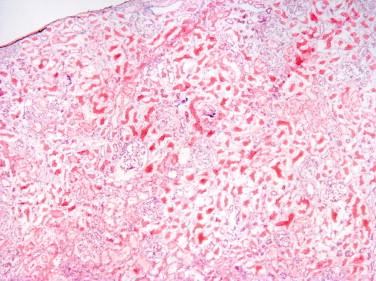
| Preparation Item | Potential Pitfall |
|---|---|
| Macroscopic organ visualization by pathologist if possible | Nonparticipation of pathologist may increase risk of unrepresentative or inadequate biopsy or failure to biopsy other suspicious lesion |
| Biopsy size | Small biopsies may not be representative. A minimum of 20-25 glomeruli (not immediately subcapsular) is desirable with artery and arteriolar branches, wedge, and/or needle biopsy by local preference. |
| Short time interval from biopsy to freezing is desirable; moistening of sample with organ preservation fluid (e.g., HTK), avoidance of saline | Tissue desiccation or extended time in fluid may simulate necrosis and interfere with glomerular assessment; saline may distort cytologic and histologic features leading to misinterpretation. |
| Brief blotting to remove excess fluid before freezing | Ice crystal formation may render cutting difficult or impossible and induces severe histologic artifacts. |
| Correct positioning of wedge biopsy for cryostat sectioning | Cutting en face from capsular surface may result in near-exclusive sampling of subcapsular glomeruli with overestimation of glomerulosclerosis in some cases; vessels are usually poorly visualized in this circumstance. |
| Appropriate section thickness (4-5 μm) | Thicker sections may simulate glomerular hypercellularity (may need 3-μm section on occasion for glomerular assessment). |
Routine frozen section assessment of donor kidney biopsy ( Table 19-5 ) focuses on examination of glomeruli, arterial/arteriolar vasculature, tubules, and interstitium, with primary focus on the first two items. Global glomerulosclerosis is easily assessed on routine hematoxylin-eosin (H&E) stain as solid globoid eosinophilic nodules. Accurate counting of the percentage of sclerotic glomeruli relative to the total glomerular count is important because clinical decisions may be made on this basis. We find that the glomerular count on wedge biopsy is facilitated by drawing a series of parallel lines with a pen on the coverslip overlying the sample because this visually subdivides the parenchyma and minimizes missing individual glomeruli or counting them twice. Care should be taken to avoid skewing the glomerular count upward due to overrepresentation of immediately subcapsular glomeruli, which tend to show a higher frequency of glomerulosclerosis ( Figure 19-2 ). Malpositioning of the tissue block may, in extreme cases, lead to exclusive sampling of subcapsular glomeruli with inflated assessment of sclerosis. In such cases, reorientation of the block or rebiopsy may avoid discarding an otherwise usable kidney. There is no universally agreed-upon cutoff beyond which to reject a donor kidney for transplant on the basis of glomerular obsolescence. Investigators from the University of Maryland have proposed a Maryland Aggregate Pathology Index (MAPI) and found an increased risk of late graft failure when glomerulosclerosis exceeded 15% (Munivenkatappa et al, 2008). We rarely use kidneys with more than 20% glomerulosclerosis. However, in some cases such kidneys may be used in a “two for one” procedure, with both kidneys placed into a single, usually older, recipient.
| Histologic Feature | Comment |
|---|---|
| Glomerulosclerosis | Rarely used if 20% or more glomerulosclerosis; some use 15% cutoff |
| Arteriosclerosis | Assessed by luminal narrowing: mild (25% narrowing or less), moderate (26%-50%), severe (> 50%); typically do not use if moderate or severe |
| Arteriolosclerosis | Requires close attention, may be easily missed; mild (focal and occasional hyaline); moderate (near circumferential to circumferential hyaline); severe (exaggerated hyalinosis or concentric fibromuscular thickening); typically do not use if moderate or severe |
| Tubular atrophy; tubular injury | Not usually a cause for organ discard unless severe or associated with infarction |
| Interstitium | Not usually a cause for organ discard unless fibrosis is severe; do not mistake interstitial expansion due to frozen section artifact for fibrosis |
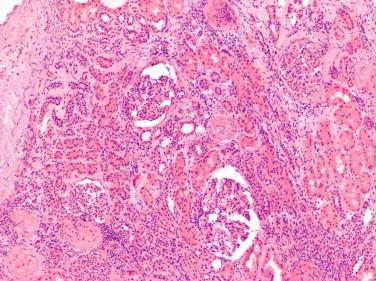
Arteriosclerosis is assessed by estimating the degree of arterial luminal narrowing related to fibrointimal expansion ( Figure 19-3 ). This can be problematic when few artery branches are present and sectioned in a roughly longitudinal direction. As the degree of obliquity of sectioning increases, the degree of arteriosclerosis is exaggerated, so the minimal degree seen is likely the most accurate representation. However, this is complicated by the fact that arteriosclerosis may also be eccentrically distributed. If the sample is large enough, it may be helpful to bisect it and mount each piece in a different orientation for sectioning to increase the chance of obtaining true arterial cross-sections.
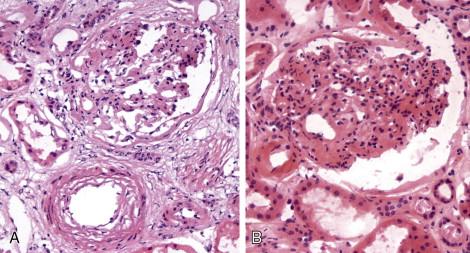
We apply the Banff scoring system (Solez et al, 2007) to assess arteriosclerosis, with less than 25% narrowing representing mild, 26% to 50% representing moderate, and greater than 50% narrowing representing severe arteriosclerosis. We do not normally utilize donor kidneys with either moderate or severe arteriosclerosis for transplant. A slightly different approach is taken in the MAPI, but this approach requires morphometry and is currently applicable to permanent section.
We also assess arteriolosclerosis as mild, moderate, or severe ( Figure 19-3 ). In general, focal hyalinosis would be considered mild, circumferential or near circumferential hyalinosis would be considered at least moderate, and significant concentric muscular “onion-skinning” would be considered severe. Particular attention should be paid to arterioles because in our experience these smaller vessels are easily overlooked on frozen section H&E stain.
Some degree of tubular injury is to be expected in these deceased donor kidneys, and we typically do not stress this feature unless it is extensive or associated with infarction. Similarly, the presence of interstitial fibrosis or inflammation is seldom a reason for rejecting a donor kidney unless extensive or if the inflammation has unusual features (see below).
Glomeruli may also show changes related to preterminal donor events or may reflect underlying disease. Glomerular capillary thrombi have a “dry” solid or reticulonodular appearance that can expand individual capillaries and entrap red cells ( Figure 19-4 ). This might reflect a thrombotic microangiopathy, often associated with trauma or sepsis. Minor degrees of capillary thrombosis typically do not impact clinical decision making. However, extensive thrombosis or associated glomerular necrosis may lead the surgeon to discard the organ. We count the number of glomeruli with thrombosis to convey the extent of this process.
| Findings | Comment | |
|---|---|---|
| Glomeruli | Capillary thrombi | Significant only if frequent or with associated glomerular necrosis; pathologist should quantitate number of involved glomeruli; some surgeons will use, regardless of extent of involvement; others will discard |
| Mesangial nodules | Most often reflects advanced diabetes, disqualifying kidney; may potentially reflect other conditions associated with nodular glomerulosclerosis | |
| Mesangial widening | Nonspecific—may reflect diabetes, IgA nephropathy, etc.; thin (3 μm) sections may aid in evaluation; not necessarily a contraindication for organ use | |
| Glomerular hypercellularity | May be overestimated with thicker sections; thin sections useful | |
| Tubules | Widespread necrosis | Size and etiology may disqualify kidney for use. (Some degree of tubule injury is common in donor kidneys and not a cause for discard.) |
| Pigmented casts | Myoglobin casts with rhabdomyolysis; case reports of successful use | |
| Interstitium | Cellular infiltrate | Should consider (uncommon) possibility of leukemic or lymphomatous infiltrate in the differential diagnosis; if present, would contraindicate use |
| Vessel | Atheromatous emboli | Should be sought because this may lead to a decision to discard organ in some cases |
| Other | Renal cell carcinoma (RCC) | Some evidence that solitary small RCC can be resected at time of transplant and kidney used; pathologist should document adequacy of resection margin |
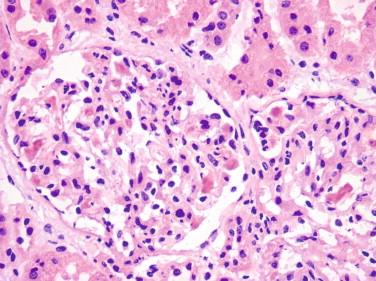
Primary glomerular disease, either suspected or unsuspected, can often be detected on frozen section despite obvious limitations relative to complete nephropathologic evaluation.
The frequency of diabetes in the United States has been estimated at 7% of the population, or approximately 20.8 million individuals; of these, the disease is undiagnosed in 30%. It is therefore necessary to always consider the possibility of underlying diabetes in potential donor organs. Diabetes mellitus may result in obvious Kimmelstiel-Wilson nodules but may also show more subtle diffuse intercapillary mesangial widening ( Figure 19-5 ). This can be overestimated both by thick sections and by the H&E stain itself. Additional 3-μm sections may provide better glomerular assessment in some cases. When doubt persists, it is best to convey this to the surgeon. Such kidneys (with milder changes) are often functional, and the decision may be made to use them in the particular clinical situation, although some evidence suggests a degree of suboptimal long-term performance.
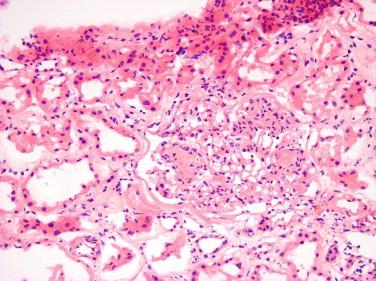
Focal segmental glomerulosclerosis can be easily missed when not consciously sought because it may affect only a small number of glomeruli. Appreciation of this condition may be difficult on frozen section, and, in cases of doubt, it is best to express this possibility to the surgeon. We are unaware of reports of progression of this disease from donor transmission, in contrast to its known potentially rapid recurrence when it is the cause of renal failure.
Proliferative glomerulonephritis can be recognized in some cases on frozen section, and thin sections, or at least nonreliance on thick sections, can be helpful. Suggestion of this condition would likely disqualify a kidney for transplant, although there are reports of resolution of such donor conditions as poststreptococcal glomerulonephritis or membranoproliferative glomerulonephritis. Therefore the ultimate decision is a clinicopathologic one.
IgA nephropathy, in particular, is quite common and can present with a variety of appearances from essentially normal-appearing glomeruli to mesangial widening to proliferative glomerulonephritis. Current opinion is that the disease does not significantly progress in the recipient. Thus the general approach of noting significant mesangial widening and hypercellular glomeruli should also provide a reasonable filter for this disease.
Become a Clinical Tree membership for Full access and enjoy Unlimited articles
If you are a member. Log in here